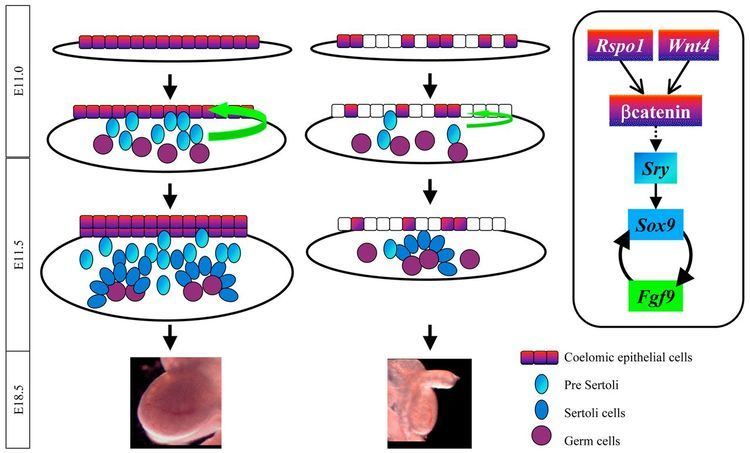Entrez 54361 | Ensembl ENSG00000162552 | |
 | ||
External IDs OMIM: 603490 MGI: 98957 HomoloGene: 22529 GeneCards: WNT4 | ||
Medical vocabulary what does wnt4 protein mean
WNT4 is a secreted protein that in humans is encoded by the Wnt4 gene, found on chromosome 1. It promotes female sex development and represses male sex development. Loss of function can have serious consequences, such as female to male sex reversal.
Contents
- Medical vocabulary what does wnt4 protein mean
- Gonadal gender 4 dax1 wnt4
- Function
- Pregnancy
- Early gonads
- Ovaries
- Male sexual development
- Kidneys
- Muscles
- Deficiency
- Serkal syndrome
- Mayer Rokitansky Kuster Hauser Syndrome
- References
Gonadal gender 4 dax1 wnt4
Function
The WNT gene family consists of structurally related genes that encode secreted signaling proteins. These proteins have been implicated in oncogenesis and in several developmental processes, including regulation of cell fate and embryogenesis.
Pregnancy
WNT4 is involved in a couple features of pregnancy as a downstream target of BMP2. For example, it regulates endometrial stromal cell proliferation, survival, and differentiation. These processes are all necessary for the development of an embryo. Ablation in female mice results in subfertility, with defects in implantation and decidualization. For instance, there is a decrease in responsiveness to progesterone signaling. Furthermore, postnatal uterine differentiation is characterized by a reduction in gland numbers and the stratification of the luminal epithelium.
Early gonads
Gonads arise from the thickening of coelomic epithelium, which at first appears as multiple cell layers. They later commit to sex determination, becoming either female or male under normal circumstances. Regardless of sex, though, WNT4 is needed for cell proliferation. In mouse gonads, it has been detected only eleven days after fertilization. If deficient in XY mice, there is a delay in Sertoli cell differentiation. Moreover, there is delay in sex cord formation. These issues are usually compensated for at birth.
WNT4 also interacts with RSPO1 early in development. If both are deficient in XY mice, the outcome is less expression of SRY and downstream targets. Furthermore, the amount of SOX9 is reduced and defects in vascularization are found. These occurrences result in testicular hypoplasia. Male to female sex reversal, however, does not occur because Leydig cells remain normal. They are maintained by steroidogenic cells, now unrepressed.
Ovaries
WNT4 is required for female sex development. Upon secretion it binds to Frizzled receptors, activating a number of molecular pathways. One important example is the stabilization of β catenin, which increases the expression of target genes. For instance, TAFIIs 105 is now encoded, a subunit of the TATA binding protein for RNA polymerase in ovarian follicle cells. Without it, female mice have small ovaries with less mature follicles. In addition, the production of SOX9 is blocked. In humans, WNT4 also suppresses 5-α reductase activity, which converts testosterone into dihydrotestosterone. External male genitalia are therefore not formed. Moreover, it contributes to the formation of the Müllerian duct, a precursor to female reproductive organs.
Male sexual development
The absence of WNT4 is required for male sex development. FGF signaling suppresses WNT4, acting in a feed forward loop triggered by SOX9. If this signaling is deficient in XY mice, female genes are unrepressed. With no FGF2, there is a partial sex reversal. With no FGF9, there is a full sex reversal. Both cases are rescued, though, by a WNT4 deletion. In these double mutants, the resulting somatic cells are normal.
Kidneys
WNT4 is essential for nephrogenesis. It regulates kidney tubule induction and the mesenchymal to epithelial transformation in the cortical region. In addition, it influences the fate of the medullary stroma during development. Without it, smooth muscle α actin is markedly reduced. This occurrence causes pericyte deficiency around the vessels, leading to a defect in maturation. WNT4 probably functions by activating BMP4, a known smooth muscle differentiation factor.
Muscles
WNT4 contributes to the formation of the neuromuscular junction in vertebrates. Expression is high during the creation of first synaptic contacts, but subsequently downregulated. Moreover, loss of function causes a 35 percent decrease in the number of acetylcholine receptors. Overexpression, however, causes an increase. These events alter fiber type composition with the production of more slow fibers. Lastly, MuSK is the receptor for WNT4, activated through tyrosine phosphorylation. It contains a CRD domain similar to Frizzled receptors.
Deficiency
Several mutations are known to cause loss of function in WNT4. One example is a heterozygous C to T transition in exon 2. This causes an arginine to cystine substitution at amino acid position 83, a conserved location. The formation of illegitimate sulfide bonds creates a misfolded protein, resulting in loss of function. In XX humans, WNT4 now cannot stabilize β-catenin. Furthermore, steroidogenic enzymes like CYP17A1 and HSD3B2 are not suppressed, leading to an increase in testosterone production. Along with this androgen excess, patients have no uteruses. Other Müllerian abnormalities, however, are not found. This disorder is therefore distinct from classic Mayer-Rokitansky-Kuster-Hauser syndrome.
Serkal syndrome
A disruption of WNT4 synthesis in XX humans produces Serkal syndrome. The genetic mutation is a homozygous C to T transition at cDNA position 341. This causes an alanine to valine residue substitution at amino acid position 114, a location highly conserved in all organisms, including zebrafish and Drosophila. The result is loss of function, which affects mRNA stability. Ultimately it causes female to male sex reversal.
Mayer-Rokitansky-Kuster-Hauser Syndrome
WNT4 has been clearly implicated in the atypical version of Mayer-Rokitansky-Kuster-Hauser Syndromefound in XX humans. A genetic mutation causes a leucine to proline residue substitution at amino acid position 12. This occurrence reduces the intranuclear levels of β-catenin. In addition, it removes the inhibition of steroidogenic enzymes like 3β-hydroxysteriod dehydrogenase and 17α-hydroxylase. Patients usually have uterine hypoplasia, which is associated with biological symptoms of androgen excess. Furthermore, Müllerian abnormalities are often found.
